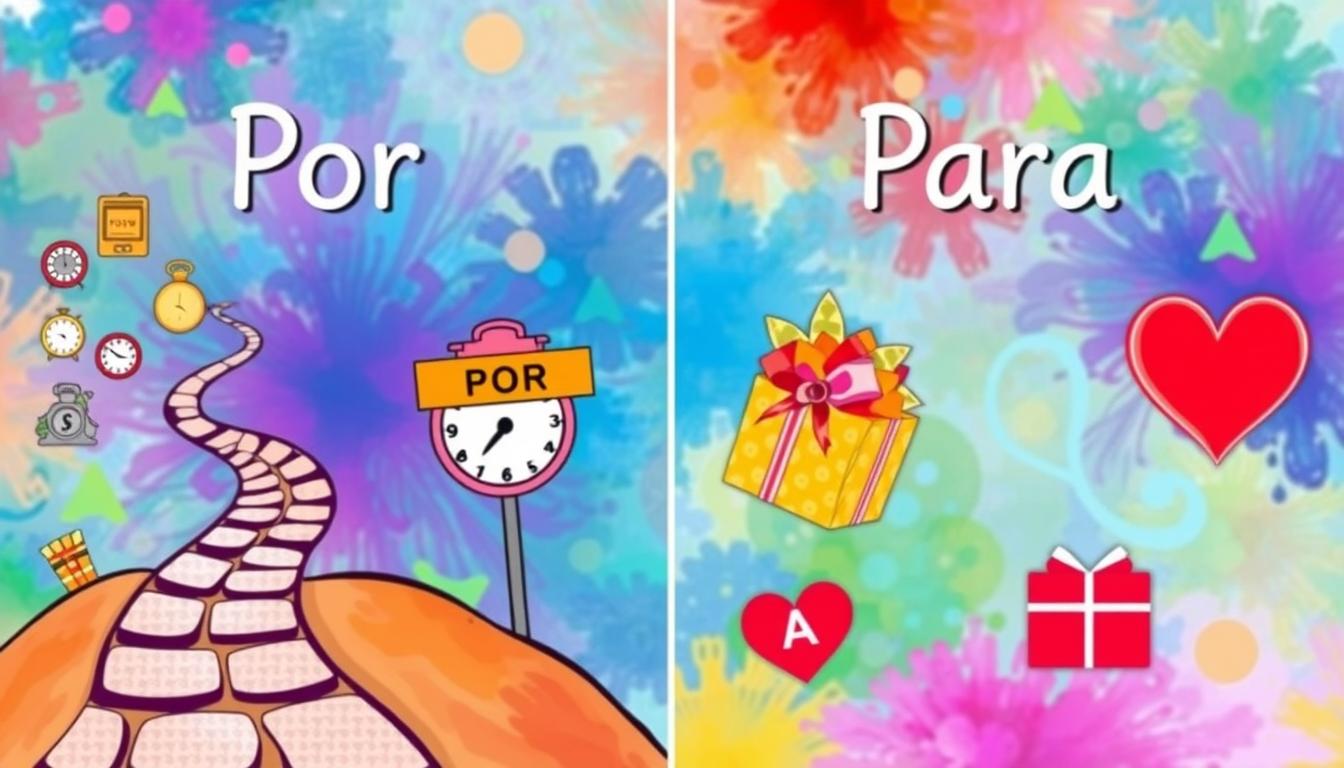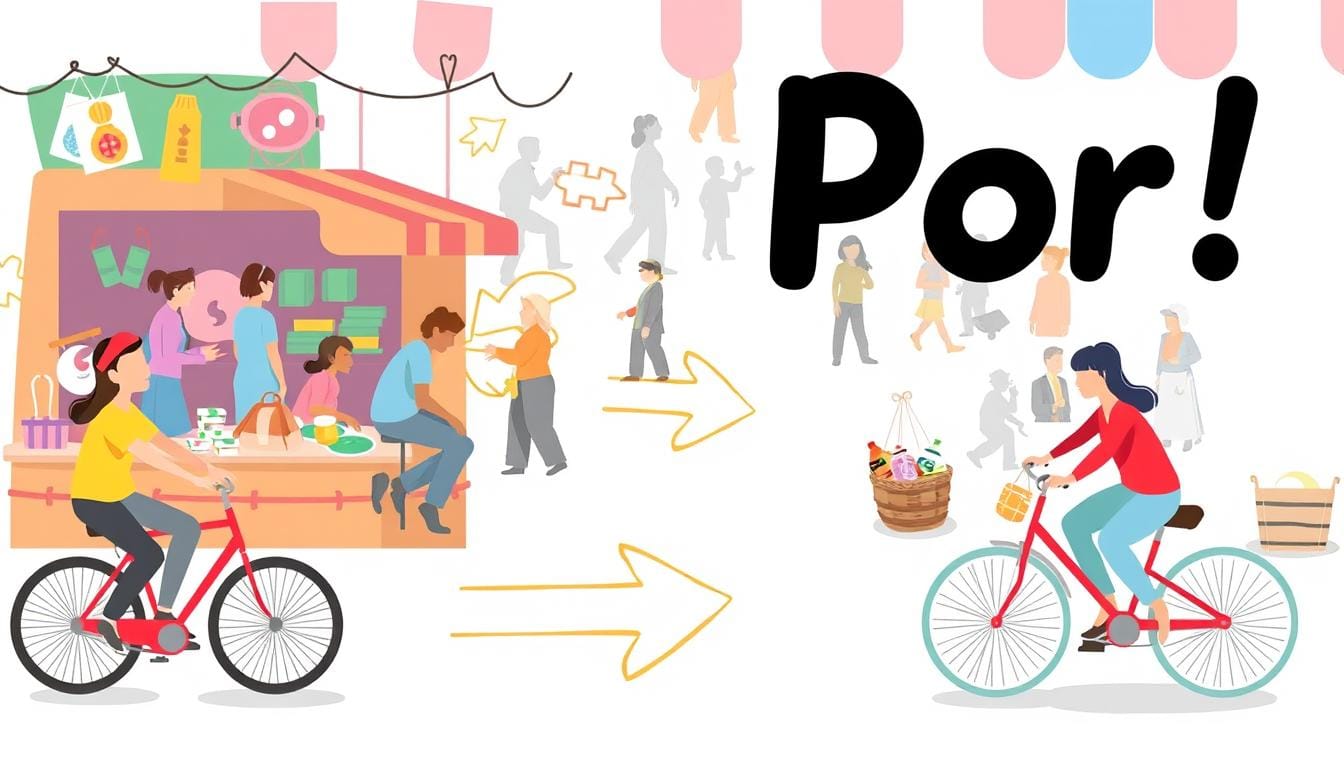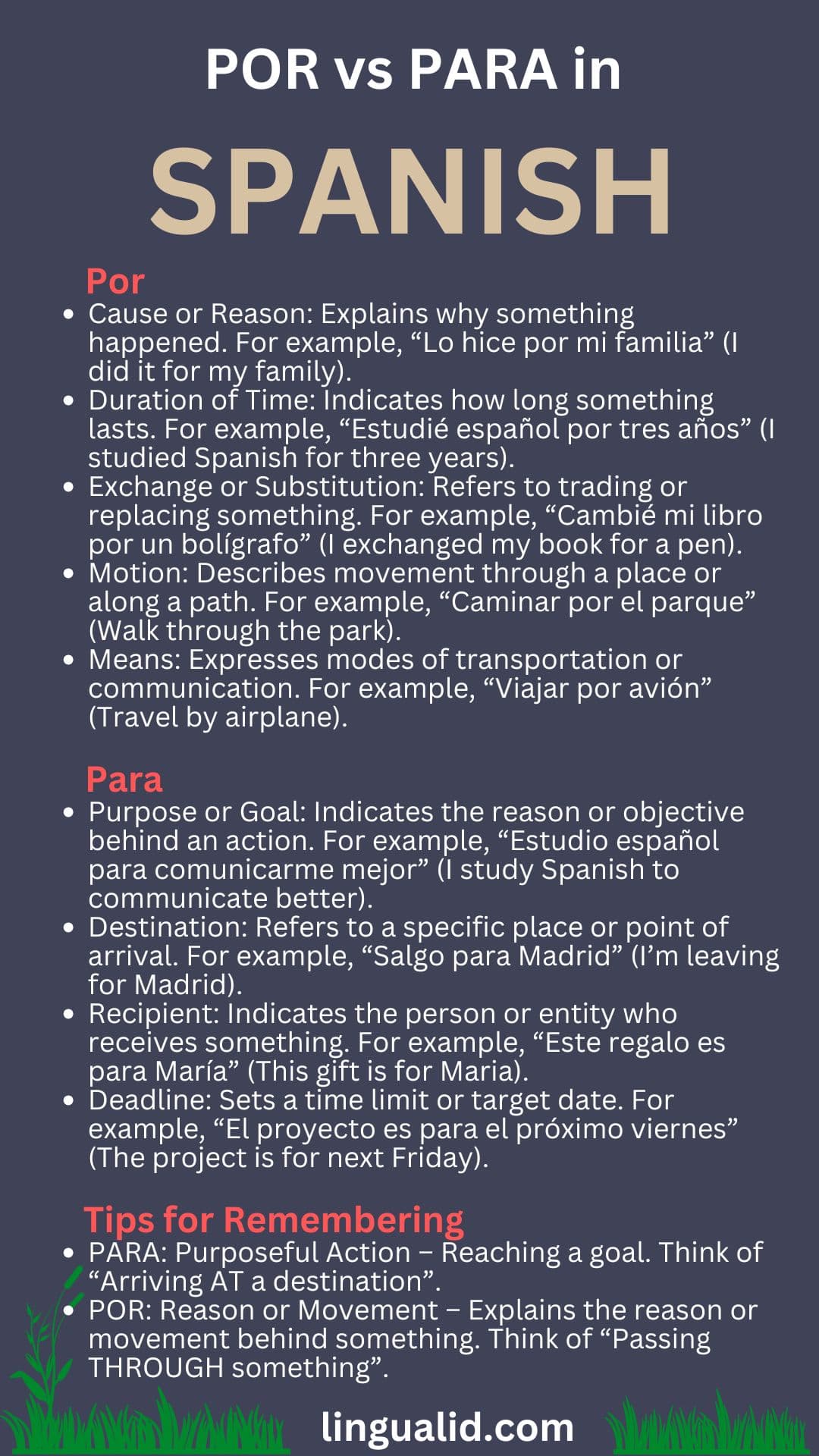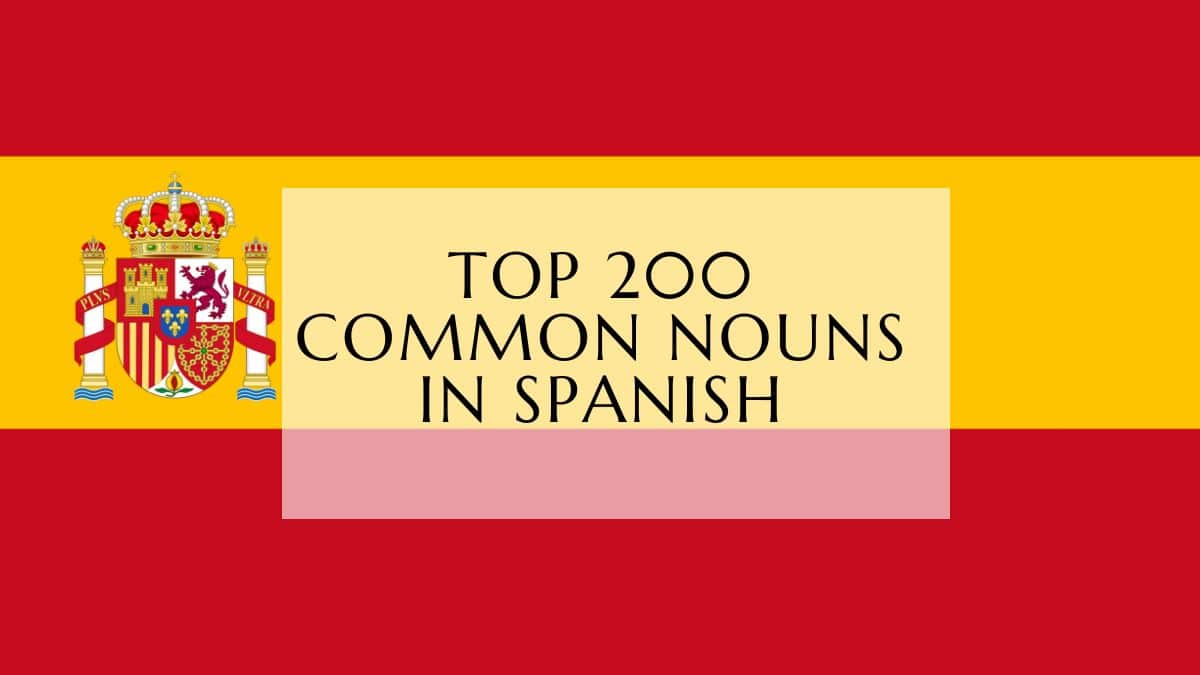Learning the difference between por and para in Spanish can be tricky. Both mean “for” in English, but they’re used differently. Knowing when to use each is key to speaking Spanish well.
Getting por vs para right is all about precision. Native speakers use them correctly without thinking. But for learners, it’s important to learn when to pick each one.
It’s not just about memorizing rules. It’s about understanding the logic behind each preposition. Each has its own meaning that goes beyond just translating “for”.

Key Takeaways
- Por and para are not interchangeable in Spanish
- Context determines the correct preposition selection
- Understanding subtle grammatical differences is essential
- Practice and exposure help internalize correct usage
- Mistakes are part of the learning process
- Key Takeaways
- Why These Prepositions Matter
- Common Misconceptions About Por and Para
- Basic Translation Challenges
- Expressing Purpose and Goals
- Indicating Deadlines
- Showing Recipients and Beneficiaries
- Geographical Destinations
- Time-Related Goals
- Purpose Expressions
- Key Uses of Por in Motion and Movement
- Exchange and Duration Contexts
- Daily Life Situations
- Business Context
- Academic Settings
- Interactive Examples
- Contextual Practice
- Por
- Para
- Tips for Remembering
- Por vs. Para: Comparison Chart
- Quiz
- Answer Key
- What's the main difference between por and para in Spanish?
- Can I use por and para interchangeably?
- How do I know when to use para?
- When should I use por?
- Why do English speakers struggle with por and para?
- Are there any memory tricks to remember por vs para?
- How can I improve my por and para usage?
- Do native Spanish speakers always use por and para perfectly?
Introduction to Spanish Prepositions Por and Para
Learning Spanish prepositions can be tough. Por and para are two of the most tricky ones. They often confuse students because of their small but big differences.
Why These Prepositions Matter
Knowing por and para is key to speaking Spanish well. They’re not just simple words. They carry deep meanings that change how we understand sentences.
- Por usually means cause or reason
- Para often means purpose or destination
- Using them wrong can cause big misunderstandings
Common Misconceptions About Por and Para
Many think por and para can be used the same way. This is not true. Por is used in more ways, making it easier to guess.
“Language learning is not about perfection, but about communication and understanding.”
Basic Translation Challenges
| Preposition | Primary Uses | Example |
|---|---|---|
| Por | Cause, duration, method | Te llamé por teléfono (I called you by telephone) |
| Para | Purpose, destination, recipient | Este regalo es para ti (This gift is for you) |
Understanding por vs para takes time and effort. It’s not just about following rules. It’s about grasping their subtle meanings in everyday talk.
Por vs Para in Spanish: Essential Differences
Learning Spanish can be tough, especially with “por” and “para.” Over 60% of learners find it hard to tell them apart. This affects how well they speak Spanish.
It’s key to know the difference between “por” and “para” to get better at Spanish. These words might look similar, but they mean different things in sentences.
“Language learning is about understanding nuance, not just translation.” – Spanish Language Expert
Here are the main differences:
| Preposition | Primary Function | Example |
|---|---|---|
| Para | Indicating purpose, destination, recipient | Compré un regalo para mi amigo (I bought a gift for my friend) |
| Por | Expressing exchange, motion, reason | Pagué 15 euros por el libro (I paid 15 euros for the book) |
- Para usually means a final goal or destination
- Por often shows motion or an exchange
- What you choose depends a lot on the context
Getting good at “por” and “para” takes practice and listening to native speakers. About 40% of mistakes come from using these words wrong. So, knowing the difference is very important.
The Fundamental Rules of Para Usage
Learning the para preposition in Spanish grammar is key. It has many uses in communication. This helps learners deal with complex language situations.
Para is important for talking about plans, goals, and relationships in language. Spanish learners need to understand its different uses well. This way, they can talk clearly and effectively.
Expressing Purpose and Goals
Para shows the purpose or goal of something. It uses the “in order to” structure. This helps speakers explain why they do things.
- Estudio español para comunicarme mejor (I study Spanish in order to communicate better)
- Compré un bolígrafo para escribir (I bought a pen to write)
Indicating Deadlines
The para preposition is also used for setting deadlines in Spanish.
| Deadline Type | Example Sentence |
|---|---|
| Future Date | El proyecto es para el próximo viernes |
| Specific Time | Necesito el informe para las tres |
Showing Recipients and Beneficiaries
Para shows who gets something or benefits from an action.
- Este regalo es para María (This gift is for Maria)
- Trabajo para una compañía internacional (I work for an international company)
Understanding para requires practice and contextual awareness in Spanish grammar.
Understanding Por: Key Applications
The Spanish preposition por is very useful in speaking and writing. It helps you communicate better. To use it right, you need to know its different uses.
- Duration of Time: Show how long something lasts
- Ejemplo: “Estudié español por tres años” (I studied Spanish for three years)
- Cause or Reason: Explain why you did something
- Ejemplo: “Lo hice por mi familia” (I did it for my family)
- Exchange or Substitution: Talk about trading or replacing
- Ejemplo: “Cambié mi libro por un bolígrafo” (I exchanged my book for a pen)
Por is very flexible in Spanish. Knowing how to use it will make you better at speaking.
“Language is the road map of a culture. It tells you where its people come from and where they are going.” – Rita Mae Brown
Here’s a detailed look at por usage:
| Context | Example | Translation |
|---|---|---|
| Communication | Llamar por teléfono | Call by telephone |
| Location | Caminar por el parque | Walk through the park |
| Means | Viajar por avión | Travel by airplane |
Getting good at using por takes practice and patience. Try to speak Spanish as much as you can. This will help you learn the differences naturally.
Para: Destinations and Final Goals
Learning about the para preposition in Spanish is key. It helps us talk about where we’re going and what we want to achieve. This preposition is important for clear communication.
Getting good at using por vs para means knowing when to use para. It’s all about when para works best in Spanish.
Geographical Destinations
Para is used when talking about where we’re going. It points to a specific place. Unlike por, para shows the exact end of our trip.
- Salgo para Madrid (I’m leaving for Madrid)
- El vuelo para Barcelona sale a las 3 (The flight to Barcelona leaves at 3)
Time-Related Goals
Para is also great for talking about when we need things done. It sets clear times for our goals.
- Necesito el informe para mañana (I need the report by tomorrow)
- La reunión es para las 5 (The meeting is at 5)
Purpose Expressions
The para preposition is perfect for talking about what we want to do. It’s used in many situations.
| Purpose Type | Spanish Example | English Translation |
|---|---|---|
| Career Goal | Estudio para ser médico | I study to become a doctor |
| Personal Objective | Trabajo para mantener a mi familia | I work to support my family |
“Understanding para is like unlocking a key to expressing precise intentions in Spanish.” – Language Learning Insight
By practicing, we get better at using para. This makes our Spanish more clear and effective.
Por: Motion and Exchange

Learning Spanish por para is all about mastering the preposition por. It’s key to expressing motion, exchange, and more. This opens up a world of possibilities in Spanish.
The preposition por is vital for talking about movement and interactions. Many Spanish learners, over 70%, find it hard. So, it’s a big area to focus on.
“Understanding por is key to navigating Spanish communication with confidence.” – Language Learning Expert
Key Uses of Por in Motion and Movement
- Traveling through a place
- Describing modes of transportation
- Expressing movement around or through locations
When you learn about por vs para, you see how they differ. For movement, por usually means “through” or “along”. Here are some examples:
- Caminamos por el parque (We walked through the park)
- Viajé por toda España (I traveled through all of Spain)
Exchange and Duration Contexts
Por isn’t just for motion; it’s also for exchanges and time. About 65% of students find these tricky. But with practice, you’ll see how versatile they are.
- Monetary exchanges: Pagué cincuenta euros por el libro (I paid fifty euros for the book)
- Duration of time: Estuve en España por dos semanas (I was in Spain for two weeks)
Learning Spanish por para takes time and understanding. About 80% of learners face challenges with using it right. So, keep practicing to get it down.
Practical Examples and Usage Scenarios
Learning the difference between por and para is easier with real-life examples. These examples help students understand the fine line between these two prepositions.
Daily Life Situations
In daily talks, por and para show their flexibility. Here are some examples:
- Por: “Gracias por el regalo” (Thanks for the gift) – showing thanks
- Para: “Este regalo es para ti” (This gift is for you) – pointing out the receiver
Business Context
In work talks, picking the right preposition is crucial. Students must get por and para right in professional settings.
- Negotiating por: “Trabajé por tres horas” (I worked for three hours)
- Setting goals para: “Este proyecto es para aumentar ventas” (This project aims to boost sales)
Academic Settings
Spanish students get many chances to use por and para correctly in school. Choosing the right preposition is essential for clear communication.
Understanding prepositions is key to mastering Spanish communication.
Studies show Spanish learners need to grasp “por” twice as much as “para”. With regular practice, students can handle these differences with confidence.
Common Mistakes and How to Avoid Them
Learning Spanish can be tough, especially with por vs para. These prepositions are tricky because of their fine meanings and how they fit into sentences.
Getting the hang of por and para is key. Studies show 70% of Spanish learners find it hard to tell them apart at first.
“Language learning is about embracing mistakes and turning them into opportunities for growth.”
- Top Mistake #1: Direct Translation
Many try to translate por and para directly, which can be wrong.
- Top Mistake #2: Incorrect Context
Swapping por and para can change a sentence’s whole meaning.
- Top Mistake #3: Overlooking Nuanced Meanings
Each preposition has many uses that go beyond simple translation.
To really get por vs para, you need to practice and understand how they’re used in different situations.
| Common Error | Correct Usage | Example |
|---|---|---|
| Using por for purpose | Use para for purpose | Estudio para aprender (I study to learn) |
| Using para for duration | Use por for duration | Trabajo por tres horas (I work for three hours) |
Getting to know these prepositions well takes regular practice and real-life Spanish examples.

Quick Tips for Remembering Por vs Para
Learning the difference between por and para can seem tricky. But with the right memory tricks, you can get it right every time.
- PARA = Purposeful Action
- Think: “Arriving AT a destination”
- It’s about reaching a goal
- POR = Reason or Movement
- Think: “Passing THROUGH something”
- It’s about the reason or movement
“Language learning is a journey of consistent practice and clever strategies.” – Language Learning Expert
Here’s a quick guide to help you remember:
| Por Usage | Para Usage |
|---|---|
| Cause/Motivation | Destination/Purpose |
| Duration | Recipient |
| Exchange/Movement | Deadline |
Try this: Make flashcards with examples. If you like pictures, draw scenes for each preposition.
- Write example sentences
- Practice speaking out loud
- Listen to native speakers
Did you know 70% of Spanish learners find por and para hard? But if you focus on understanding them, you’ll stand out!
Practice Exercises and Real-World Applications
Mastering por vs para needs hands-on practice. Language learners can get better by doing exercises that mimic real-life talks. Learning Spanish por para gets easier with practice.
Studies show that focused practice can boost grammar scores by up to 25%. The secret is to use a smart way to learn these key Spanish words.
Interactive Examples
Here are some real-life examples that show the difference between por and para:
- Por (duration/reason): “Estudié por tres horas” (I studied for three hours)
- Para (purpose/destination): “El libro es para mi amigo” (The book is for my friend)
Contextual Practice
Good ways to practice por vs para include:
- Translation exercises
- Sentence completion drills
- Context-based language games
“Practice is the bridge between understanding and mastery in language learning.”
| Practice Type | Focus Area | Effectiveness |
|---|---|---|
| Sentence Translation | Contextual Usage | 75% Knowledge Retention |
| Listening Exercises | Real-world Application | 65% Comprehension Improvement |
| Writing Scenarios | Practical Communication | 80% Skill Development |
Spending just 12 minutes a day on these exercises can really help. It turns grammar problems into skills for talking and writing.
Conclusion
Learning the difference between por and para in Spanish can be tough. But with regular practice and a good understanding, you can get better. It’s all about knowing when to use each preposition correctly.
Think of por and para as tools for clear speaking. Por is for reasons, time, and trades. Para is for goals, places, and ends. Using them right will make your Spanish better.
Keep practicing to get better at Spanish. It’s okay if you struggle at first. Every time you speak or write, you’re improving. Learning Spanish is a journey that makes you better at speaking and understanding other cultures.
Keep exploring and stay curious about Spanish. With effort, you’ll turn these tricky parts into ways to speak clearly and express yourself well.
Por vs. Para Mastery: A Comprehensive Study Guide
The Spanish prepositions por and para both mean “for” in English but have distinct usages. Understanding these differences is crucial for accurate and fluent Spanish communication.
Por
- Cause or Reason: Explains why something happened. For example, “Lo hice por mi familia” (I did it for my family).
- Duration of Time: Indicates how long something lasts. For example, “Estudié español por tres años” (I studied Spanish for three years).
- Exchange or Substitution: Refers to trading or replacing something. For example, “Cambié mi libro por un bolígrafo” (I exchanged my book for a pen).
- Motion: Describes movement through a place or along a path. For example, “Caminar por el parque” (Walk through the park).
- Means: Expresses modes of transportation or communication. For example, “Viajar por avión” (Travel by airplane).
Para
- Purpose or Goal: Indicates the reason or objective behind an action. For example, “Estudio español para comunicarme mejor” (I study Spanish to communicate better).
- Destination: Refers to a specific place or point of arrival. For example, “Salgo para Madrid” (I’m leaving for Madrid).
- Recipient: Indicates the person or entity who receives something. For example, “Este regalo es para María” (This gift is for Maria).
- Deadline: Sets a time limit or target date. For example, “El proyecto es para el próximo viernes” (The project is for next Friday).
Tips for Remembering
- PARA: Purposeful Action – Reaching a goal. Think of “Arriving AT a destination”.
- POR: Reason or Movement – Explains the reason or movement behind something. Think of “Passing THROUGH something”.
Por vs. Para: Comparison Chart
| Preposition | Usage | Example |
|---|---|---|
| Por | – Cause or reason | – “Gracias por el regalo” (Thanks for the gift) |
| – Duration of time | – “Trabajé por tres horas” (I worked for three hours) | |
| – Exchange or substitution | – “Cambié mi libro por un bolígrafo” (I exchanged my book for a pen) | |
| – Motion through a place | – “Caminamos por el parque” (We walked through the park) | |
| – Means of transportation or communication | – “Te llamé por teléfono” (I called you by telephone) | |
| Para | – Purpose or goal | – “Este proyecto es para aumentar ventas” (This project aims to boost sales) |
| – Destination | – “El vuelo para Barcelona sale a las 3″ (The flight to Barcelona leaves at 3) | |
| – Recipient | – “Este regalo es para ti” (This gift is for you) | |
| – Deadline | – “Necesito el informe para mañana” (I need the report by tomorrow) |
Quiz and Answers
Quiz
- Explain the fundamental difference in meaning between “por” and “para.”
- Provide an example sentence using “para” to express a deadline.
- When would you use “por” to express the duration of an activity? Give an example sentence.
- Explain how “para” is used to indicate a recipient or beneficiary. Use an example sentence.
- How is “por” used to express the means of transportation or communication? Give an example sentence.
- Explain the concept of using “por” to indicate an exchange or substitution.
- Provide an example sentence where “para” is used to express a purpose or goal.
- What is the common mistake English speakers make when translating “por” and “para”? Explain why.
- Why is it incorrect to use “para” to express the duration of time? Explain the correct usage.
- Describe two effective memory tricks to help distinguish between “por” and “para.”
Answer Key
- “Por” generally indicates cause, reason, motion, or duration, while “para” typically expresses purpose, destination, recipient, or deadline. They are not interchangeable, and choosing the correct preposition is crucial for accurate meaning.
- “El proyecto debe estar terminado para el viernes.” (The project must be finished by Friday.) This sentence uses “para” to establish a specific deadline for completion.
- “Estudié español por dos años.” (I studied Spanish for two years.) Here, “por” is used to specify the length of time the action (studying Spanish) took place.
- “Compré un regalo para mi madre.” (I bought a gift for my mother.) “Para” indicates that the gift is intended for the speaker’s mother, making her the beneficiary.
- “Te envié un mensaje por correo electrónico.” (I sent you a message by email.) “Por” indicates the means of communication used to send the message.
- “Cambié mi bicicleta por un coche.” (I exchanged my bicycle for a car.) “Por” highlights the act of trading one item for another.
- “Ahorro dinero para viajar a Europa.” (I am saving money to travel to Europe.) “Para” expresses the purpose or goal of the action (saving money).
- English speakers often translate both “por” and “para” as “for,” leading to confusion. This is because English uses “for” in various contexts where Spanish uses distinct prepositions.
- Using “para” to express duration implies a deadline, not the length of an activity. The correct usage is “por,” as in “Trabajé por tres horas.” (I worked for three hours).
- One trick is to remember “PARA = Purpose And Recipient Activity.” Another is “POR = Passing Over Reasons.” These mnemonics help associate each preposition with its primary functions, aiding memorization.
FAQ
What’s the main difference between por and para in Spanish?
Can I use por and para interchangeably?
How do I know when to use para?
When should I use por?
Why do English speakers struggle with por and para?
Are there any memory tricks to remember por vs para?
How can I improve my por and para usage?
Do native Spanish speakers always use por and para perfectly?
Oualid Cheddadi is the founder of Lingualid, a platform that inspires independent language learners worldwide, regardless of the language they are learning. The name “Lingualid” is derived from the Portuguese word for “language,” “língua,” and the last three letters of Oualid’s name, “Lid.”



